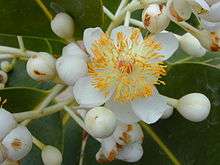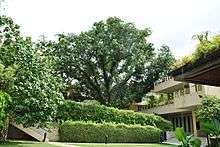Calophyllum inophyllum
| Calophyllum inophyllum | |
|---|---|
 | |
| Scientific classification | |
| Kingdom: | Plantae |
| (unranked): | Angiosperms |
| (unranked): | Eudicots |
| (unranked): | Rosids |
| Order: | Malpighiales |
| Family: | Calophyllaceae |
| Genus: | Calophyllum |
| Species: | C. inophyllum |
| Binomial name | |
| Calophyllum inophyllum L.[2] | |
Calophyllum inophyllum is a large evergreen, commonly called Alexandrian laurel[2][3] balltree,[2] beach calophyllum,[2] beach touriga,[2] beautyleaf,[2] Borneo-mahogany,[2] Indian doomba oiltree,[2] Indian-laurel,[2] laurelwood,[2] red poon,[4] satin touriga,[2] and tacamahac-tree.[2] It is native from East Africa, southern coastal India to Malesia and Australia.
Description

C. inophyllum is a low-branching and slow-growing tree with a broad and irregular crown. It usually reaches 8 to 20 m (26 to 66 ft) in height. The flower is 25 mm (0.98 in) wide and occurs in racemose or paniculate inflorescences consisting of four to 15 flowers. Flowering can occur year-round, but usually two distinct flowering periods are observed, in late spring and in late autumn. The fruit (the ballnut) is a round, green drupe reaching 2 to 4 cm (0.79 to 1.57 in) in diameter and having a single large seed. When ripe, the fruit is wrinkled and its color varies from yellow to brownish-red.
Distribution and habitat
C. inophyllum is native to Africa in: Comoros; Kenya; Madagascar; Mauritius; Mozambique; Seychelles; Tanzania (including Pemba Island of the Zanzibar Archipelago); south, southeast and east Asia in: Burma; Cambodia; China (on Hainan); southern India; Andaman and Nicobar Islands Indonesia; Japan (Ryukyu Islands); Malaysia; Papua New Guinea; the Philippines; Sri Lanka; Taiwan; Thailand; Vietnam; the northwestern, southwestern and south central Pacific Region in: the Cook Islands; Fiji; French Polynesia (Marquesas and Society Islands); Guam; the Marshall Islands; Micronesia; the Northern Mariana Islands; Palau; and Samoa; and in Australia in: Northern Territory and Queensland.[2]

Now, it is widely cultivated in all tropical regions of the world.[2] Because of its decorative leaves, fragrant flowers, and spreading crown, it is best known as an ornamental plant.[2]
This tree often grows in coastal regions, as well as nearby lowland forests. However, it has also been cultivated successfully in inland areas at moderate altitudes. It tolerates varied kinds of soil, coastal sand, clay, or even degraded soil.
Uses
Besides being a popular ornamental plant, its wood is hard and strong and has been used in construction or boatbuilding. Traditional Pacific Islanders used Calophyllum wood to construct the keel of their canoes while the boat sides were made from breadfruit (Artocarpus altilis) wood. It is sometimes used for backs and sides of entry-level acoustic guitars.
The seeds yield a thick, dark green tamanu oil for medicinal use or hair grease. The nuts are dried before cracking, after which the oil-laden kernel is removed and further dried. The first neoflavone isolated from natural sources (1951) was calophyllolide from C. inophyllum seeds.[5]
The Mavilan, a Tulu-speaking tribe in north Kerala in India, use the bark to make a powder that they mix with water and apply it to plants affected by a type of plant disease caused by water that they call neeru vembu.[6]
The sap of the tree is poisonous and is used to make poison arrows in Samoa. The mature fruit is poisonous enough to use as rat bait.
The fatty acid methyl esters derived from C. inophyllum seed oil meets the major biodiesel requirements in the United States (ASTM D 6751), and European Union (EN 14214). The average oil yield is 11.7 kg-oil/tree or 4680 kg-oil/hectare. In the northwest coastal areas of Luzon island in Philippines, the oil was used for night lamps. This widespread use started to decline when kerosene became available, and later on electricity. It was also used as fuel to generate electricity to provide power for radios during World War II.
The tree is regarded as sacred in some Pacific islands because of its excellent growth in sandy soil as shade tree and many uses.
References
- ↑ Stevens, P.F. (1998). "Calophyllum inophyllum". IUCN Red List of Threatened Species. IUCN. 1998: e.T33196A9760536. doi:10.2305/IUCN.UK.1998.RLTS.T33196A9760536.en. Retrieved 10 March 2017.
- 1 2 3 4 5 6 7 8 9 10 11 12 13 14 15 Calophyllum inophyllum was first described and published in Species Plantarum 1:513. 1753. GRIN (March 8, 2012). "Calophyllum inophyllum information from NPGS/GRIN". Taxonomy for Plants. National Germplasm Resources Laboratory, Beltsville, Maryland: USDA, ARS, National Genetic Resources Program. Retrieved April 26, 2012.
---
- ↑ Mabberley, D.J. (1997). The plant book: A portable dictionary of the vascular plants. Cambridge: Cambridge University Press.
- ↑ Kathirithamby-Wells, J. (2005). Nature and nation: Forests and Development in Peninsular Malaysia. University of Hawaii Press. p. xvi,34.
- ↑ Neoflavones. 1. Natural Distribution and Spectral and Biological Properties. M. M. Garazd, Ya. L. Garazd and V. P. Khilya, Chemistry of Natural Compounds, Volume 39, Number 1 / janvier 2003.
- ↑ Suresh, K. P. (2010). Indigenous Agricultural Practices among Mavilan Tribe in North Kerala.
Further reading
External links
 Media related to Calophyllum inophyllum at Wikimedia Commons
Media related to Calophyllum inophyllum at Wikimedia Commons- Dressler, S.; Schmidt, M. & Zizka, G. (2014). "Calophyllum inophyllum". African plants – a Photo Guide. Frankfurt/Main: Forschungsinstitut Senckenberg.
